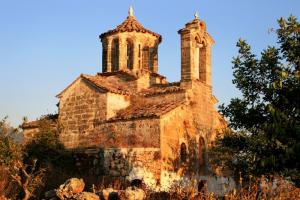 Dated as far back as the 4th Century, the earliest Christian pilgramages were made to sites connected with the birth, life, crucifixion, and resurrection of Jesus. It is believed by many sources Helena, the mother of the Roman Emperor Constantine the Great, encouraged them. Complete with packaged tours, and plenty of rooms at the inns, Christian pilgramages in the Sea of Galilee region became a tourist industry during the Byzantine Period.
Dated as far back as the 4th Century, the earliest Christian pilgramages were made to sites connected with the birth, life, crucifixion, and resurrection of Jesus. It is believed by many sources Helena, the mother of the Roman Emperor Constantine the Great, encouraged them. Complete with packaged tours, and plenty of rooms at the inns, Christian pilgramages in the Sea of Galilee region became a tourist industry during the Byzantine Period.
The Byzantine Empire arose out of Eastern Rome during the Late Antiquity and the Middle Ages. Eastern Orthodox Christianity helped characterize this dynasty. Emperor Constantine legalized Christianity. Somewhere between 379-395AD, under Roman Emperor Theodorius, Christianity became the official State Religion.
During the Third Century, due to being united under the Macedonian Empire, and adaptation of the Greek culture, the eastern portion of the Roman Empire was more urbanized than the western portion.
Emperor Constantine established a second Rome on the site of the region's city of Byzantium. This was located on the major trade routes that linked Europe and Asia, as well as the Mediterranean Sea and the Black Sea.
Constantine supported Christianity with imperial preferences and special privileges. The State Church of the Roman Empire was launched. Persecution of Christians terminated under Constantine. This became known as "the peace of the church," and the "Constantine Shift" that created an alliance between Rome and the church. "Caesarpapism," a combining of the social and political powers of the State, with the religious power of the church, came to exist.
Constantine issued the Edict of Milan in 313AD that decriminalized Christian worship in the Roman empire. The decree also afforded Christians relief from persecution. This led to a precedent for the position of the Christian Emperor in the church.
The notions of orthodoxy (authorized or generally accepted doctrine), Christendom (worldwide body of Christians), and ecumenical councils, all derived from the Edict of Milan.
The State Church of the Roman Empire developed after the three Emperors Theodorius, Gratian, and Valentinian II, co-issued the Edict of Thessalonica in 380AD. This decree recognized the catholic orthodoxy of Nicene Christians in the Great Church. It also condemned the Arian Creed as heresy.
Arian theology held that Jesus is the Son of God, who was begotten by God the Father, with the difference being that the Son of God did not always exist but was begotten within time by God the Father. Therefore, Jesus was not co-eternal with God the Father and is subordinate to Him.
In the views of the Eastern Orthodox Church, the Oriental Orthodox Church, and some Eastern Catholic Churches, Constantine's example as a Christian Monarch made him revered as a saint and equal to the apostles.
Rome and the Christians did not always see eye to eye with one another during the Byzantin Period. For about two and a half centuries, Christians were persecuted. A classic example is Nero blaming Christians for the Great Fire of Rome in 64AD. That same year, possibly because of this fire, Peter and Paul are thought to have been martyred under Nero.
Another example was all Christians who refused to participate in the Imperial Cult that diefied Emperors were considered to have committed treason punishable by death. During the Great Persecution, from 303-311AD, the Emperor Diocletian ordered Christian buildings and homes to be destroyed and their sacred books burned. He arrested Christians, had them mutilated, tortured, starved, burned, and tossed into gladiator battles for spectator amusement, or lion food.
Though he opposed Christians, in 311AD, Emperor Galerius Maximianus issued the Edict of Toleration that ended the Diocletian persecution of Christianity in the Eastern Roman Empire. This was the first decree by an Emperor to legalize Christianity. However, the edict did not restore property to Christians.
Next Time: Sea Of Galilee - #7: Battle of Hattin
Author Notes
The churches of Mani, by avmurray, selected to complement my article.
So, thanks avmurray, for the use of your picture. It goes so nicely with my article.
|
|



